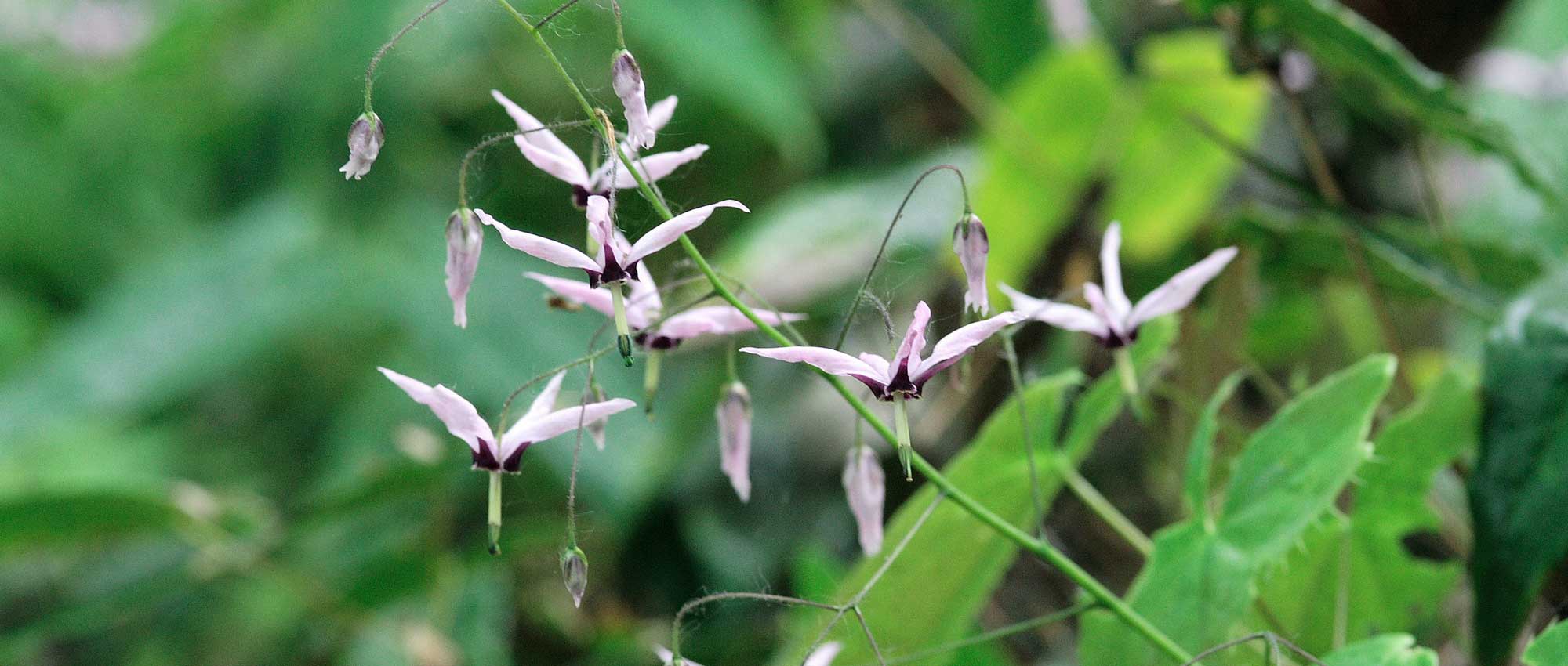
Epimedium, barrenwort: planting, growing and care
Contents
Epimedium in a nutshell
- Epimedium is a perennial plant suited to shady situations
- It is appreciated for its extremely light and delicate flowering
- The flowers offer a beautiful palette of colours, often featuring soft and warm shades
- It is an excellent ground cover
- Its foliage is decorative, often evergreen and colourful, changing throughout the seasons
- It is a very resilient plant that requires little maintenance!
A word from our Expert
Epimediums are beautiful perennials suited to shade, forming a ground cover and offering delicate flowering in spring. They bear very small, fairy-like flowers that can literally enchant a corner of your garden! Their shape resembles that of columbines, and they are held above the foliage by long, flexible stems. This gives the plant its lovely name, Flower of the Elves. They brighten the darkest areas of the garden in spring. From the lilac-pink flowers of Epimedium grandiflorum to the orange flowers of Epimedium warleyense, not to mention the small white and yellow flowers of Epimedium sagittatum… barrenworts offer a beautiful diversity!
The dense foliage of epimediums makes them excellent ground covers. The leaves often take on stunning hues in spring and autumn, sometimes with coppery, brown, or purple shades. This is the case with Epimedium versicolor, whose young leaves are beautifully marbled with copper-red. Depending on the varieties, the foliage can be deciduous or evergreen.
Epimediums prefer to be planted in shade or partial shade, for example in woodland areas, in rather cool soil. They are perfect for dressing the base of trees. These plants spread slowly thanks to their rootstocks. They thrive in the garden for years, requiring almost no maintenance. They are very resistant to diseases and pests!
Botany
Botanical data
- Latin name Epimedium sp.
- Family Berberidaceae
- Common name barrenwort, Warley bishop's hat, Elf Flower
- Flowering in April-May
- Height between 15 and 60 cm
- Exposure shade or partial shade
- Soil type cool, draining, rich in humus
- Hardiness between -13 and -15 °C
Epimediums comprise between 40 and 60 species of hardy perennial plants, which can be deciduous or evergreen. They are found in nature from Europe to Asia, with the majority originating from China, where they typically grow in woodlands. In France, only one species is found in the wild: Epimedium alpinum, which comes from Central and South-Eastern Europe and has naturalised in some regions of France.
Epimediums belong to the botanical family Berberidaceae, which includes between 600 and 800 species, some of which are commonly cultivated bushes, such as barberries, mahonias, and nandina (sacred bamboo).
Epimediums are slow-growing plants with a spreading habit. They never grow very tall, often around 30 cm in height, never exceeding 60 cm. They spread through their rootstocks, forming excellent ground covers.
Epimedium flowers in spring, typically in April-May, sometimes extending into June. The flowering period is not very long. The flowers are gathered in clusters with a rather loose habit. They are held above the leaves by long, thin, and flexible flower stems. The flowers seem to float there, as if suspended in the air.
The flowers offer a beautiful range of colours: they can be purple, yellow, orange, red, pink, or white, even beige or cream… The shades are quite soft and bright, sometimes in warm tones. Use the varieties with light or bright colours to enliven a woodland and bring brightness to it! The flowers are sometimes bicoloured, often shaded (for example, dark pink in the centre and light pink on the outside).
Epimediums provide a truly original flowering, sometimes quite discreet. The flowers are very small and gathered in clusters. When looked at closely, they take on different shapes depending on the varieties. Often, they resemble little elf hats. Those of Epimedium grandiflorum, with their very long spurs, resemble orchid flowers or small columbine flowers. The epimediums stellulatum have slightly more regular flowers, resembling small four-branched stars. The Epimedium pinnatum ssp. colchicum has much wider and rounder petals, giving the flower a brighter and coarser appearance.

Epimediums offer a beautiful diversity of flowers! From left to right, Epimedium grandiflorum var. thunbergianum (photo Alpsdake), Epimedium warleyense (photo Chris Mealy), Epimedium stellulatum ‘Wudang Star’ and Epimedium alpinum (photo Anneli Salo)
The flowers consist of eight sepals: four small outer sepals that fall quite early, arranged around four larger inner sepals, which are more colourful and resemble petals. The flowers also have four petals, extended into spurs. It is often the spurs, varying in length depending on the varieties, that give epimedium flowers their original shapes. They contain nectar. The epimedium flower also has four stamens, placed in the centre.
As its name suggests, the largest flowers are found on Epimedium grandiflorum, where they can reach a maximum diameter of 5 cm. In other species and varieties, they rarely exceed 2 cm in diameter.
The leaves of epimedium are compound, divided into leaflets. The number of leaflets varies greatly depending on the species and varieties: Epimedium diphyllum has only two leaflets, while other varieties can have up to 17. However, it is more often between five and nine. The leaves of epimedium are quite thick and leathery. They are cordate (heart-shaped): the base of the leaf forms two rounded lobes around the petiole, and the lamina is pointed at its tip. The leaflets of Epimedium versicolor ‘Sulphureum’ have lovely shapes, very soft and rounded. In contrast, the epimedium ‘Sphinx Twinkler’ has very elongated, pointed foliage, with wavy edges dotted with thorns. It is said that the leaves are sagittate (= arrow-shaped). The leaflets are sometimes dentate, but also more or less spiny along the edge of the lamina. Those of Epimedium pauciflorum, bordered with thorns, resemble holly leaves.

The foliage of epimediums can take on different forms: more or less spiny, quite rounded or more elongated… From left to right, Epimedium versicolor ‘Sulphureum’ (photo Salicyna), Epimedium pauciflorum and Epimedium ‘Sphinx Twinkler’
Generally, the leaves of epimediums change colour throughout the seasons, particularly in spring when they are young, and in autumn. They then adorn themselves with beautiful red or brown colours, sometimes purplish. The patterns on the leaves can take the form of marbling (showing the veins that remain green), round spots, or a border along the edge of the lamina. The Epimedium rubrum has really interesting foliage, with a tender green lamina, marbled with intense red in spring (around the veins that remain green!), then its leaves turn green, taking on a brown-red hue in autumn.

The colourful foliage of Epimedium rubrum
Epimediums can be deciduous or evergreen. The epimediums warleyense, versicolor, pubigerum, perralderianum, and alpinum are evergreen. They remain decorative in winter. Generally, new leaves appear in spring, replacing the old ones. The foliage thus regenerates. Epimediums grandiflorum, on the other hand, are deciduous.
Epimediums have very dense foliage, which allows them to effectively smother weeds. They form true carpets of leaves, very opaque.
Epimedium also has rootstocks, which allow it to spread into a dense mat. This makes it an excellent ground cover!
The fruit of epimedium is a capsule, a dry fruit that opens at maturity by two valves to release the seeds. Epimediums cannot self-fertilise. Thus, they tend to hybridise easily in the garden.
Read also
Hellebores: planting, growingThe main varieties of epimediums
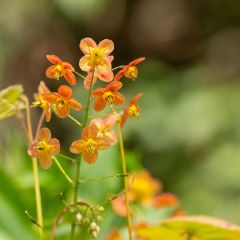
Epimedium x warleyense - Barrenwort
- Flowering time May, June
- Height at maturity 40 cm

Epimedium Amber Queen - Barrenwort
- Flowering time May to July
- Height at maturity 45 cm
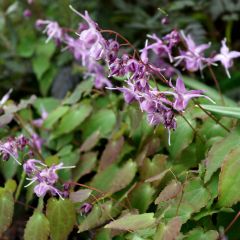
Epimedium grandiflorum Lilafee - Fairy Wings
- Flowering time May, June
- Height at maturity 30 cm
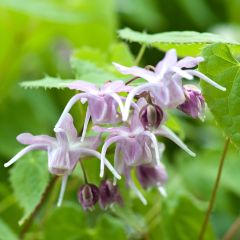
Epimedium grandiflorum - Fairy Wings
- Flowering time May, June
- Height at maturity 30 cm
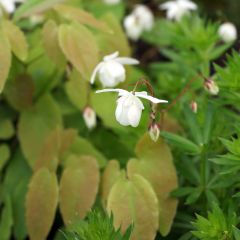
Epimedium x youngianum Niveum - Barrenwort
- Flowering time May, June
- Height at maturity 30 cm
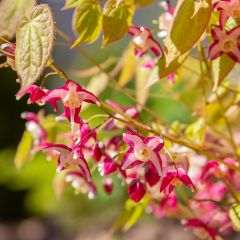
Epimedium x rubrum - Barrenwort
- Flowering time May, June
- Height at maturity 25 cm
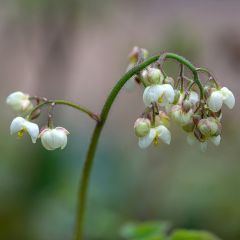
Epimedium pubigerum - Barrenwort
- Flowering time May, June
- Height at maturity 30 cm
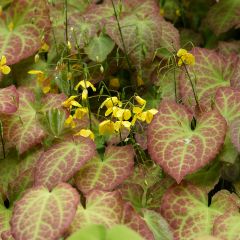
Epimedium perralchicum Fröhnleiten - Barrenwort
- Flowering time May, June
- Height at maturity 40 cm
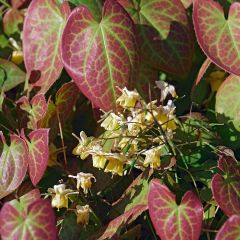
Epimedium x versicolor Sulphureum - Barrenwort
- Flowering time May, June
- Height at maturity 40 cm
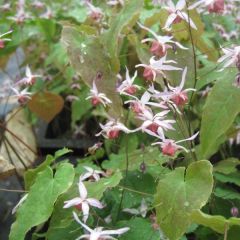
Epimedium Pink Elf - Barrenwort
- Flowering time May, June
- Height at maturity 30 cm
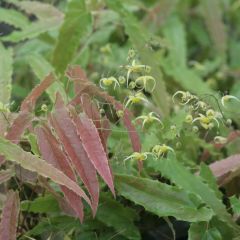
Epimedium Sphinx Twinkler - Barrenwort
- Flowering time May, June
- Height at maturity 35 cm
Discover other Epimedium - Barrenwort
View all →Available in 2 sizes
Available in 2 sizes
Available in 1 sizes
Available in 1 sizes
Available in 1 sizes
Available in 1 sizes
Available in 1 sizes
Available in 1 sizes
Available in 1 sizes
Available in 2 sizes
Planting
Where to plant?
Plant epimediums in shade or partial shade. For example, you can use them to dress the base of your trees or bushes. Avoid placing them in direct sunlight. Overall, they tolerate dense shade quite well, although the ideal situation is to plant them in bright, light shade. However, Epimedium versicolor and pubigerum tolerate sunlight better than other species.
Epimediums prefer rather cool soils. Avoid soils that dry out easily! However, once well established after a few years, they are relatively drought-resistant. Epimedium perralderianum, warleyense and perralchicum tolerate dry soils more easily than other varieties. We also recommend choosing a location sheltered from the wind.
Install your epimediums in rich, fertile humus soil. The ideal for them is a forest-type soil, good woodland earth. It is advisable to add some well-decomposed compost at the time of planting. Regular additions of organic matter will enrich your soil and make it a little less dry.
Take advantage of epimediums to enhance areas where other plants do not thrive! You can, for example, place them at the back of the garden, in a shaded area that is difficult to cultivate and maintain. They will beautifully occupy the space. Use them to smother weeds and green up slopes or the most remote and shaded areas of your garden.
Epimediums can also be planted in a shaded and cool rockery.
When to plant?
Plant epimediums between late summer and early autumn (September-October), or in early spring.
How to plant?
- First, we recommend placing the root ball in a basin filled with water to moisten it and facilitate recovery.
- Dug the planting hole. It should be two to three times larger than the size of the root ball. Add some well-decomposed compost.
- Place the epimedium in the planting hole.
- Fill in with soil and firm down.
- Water generously.
- It is advisable to install a layer of mulch at the base of the plant. This will keep the soil cool and provide some protection for the epimedium from the cold in winter.
We recommend regular watering during the year of planting.
Read also
Ferns: growing and plantingCare
Epimedium is a long-lived plant that requires relatively little maintenance. Its dense foliage smothers weeds, making weeding unnecessary. However, some varieties do not tolerate prolonged droughts: do not hesitate to water during the summer, as it is preferable for the soil to remain cool. Nevertheless, after several years, epimediums become relatively drought-resistant. The Epimedium perralderianum, warleyense and perralchicum are among the most drought-resistant and can therefore go without watering.
As epimediums thrive in rich, fertile soils, you can make a contribution of well-decomposed compost each autumn by placing it at the base of your epimediums and lightly scratching the surface of the soil.
Epimedium is very rarely affected by diseases. It may exceptionally be impacted by the mosaic virus. The leaves discolour, forming patches that resemble mosaics. Otiorhynchus beetles can also attack epimediums. These beetles have larvae that consume the plant’s roots while the adults nibble on the foliage. To get rid of them, you can use nematodes (Heterorhabditis bacteriophora), which parasitise the larvae of otiorhynchus beetles.
It is sometimes recommended to cut back the leaves to ground level at the end of winter (February – March), as this allows the young leaves and flowering to stand out more. However, the foliage protects the plant from the cold, and some recent varieties do not need to be pruned at all. In any case, if you do intervene, do it early enough: avoid pruning after the beginning of spring to prevent cutting the developing young flowering stems.

The flowering of epimedium ‘Amber Queen’
Multiplication
To multiply corydalis, we recommend clump division, as it is the simplest and most effective technique. Sowing is also possible, but it takes more time; corydalis hybridise easily, and seeds do not store well: they must be sown immediately.
Clump Division
You can easily multiply corydalis by dividing the clumps. Preferably do this in summer or early autumn, between July and September.
Identify the clump to divide, then dig around it quite widely. Remove the rootball, and if necessary, remove any excess soil. Divide the clump by cutting the rootstocks into several fragments, ensuring that each one retains enough roots. Each fragment should have roots and leaves. Optionally remove any dead leaves and damaged roots. Replant in a new location, maintaining a planting distance of 30 to 40 cm, then water generously.
Association
Use epimedium as ground cover in a woodland setting, alongside wild and natural-looking plants: with bluebells (Hyacinthoides non-scripta), the yellow flowers of the common primrose (Primula veris), or the small white flowers of sweet woodruff (Galium odoratum), which bloom at the same time! Add ferns, hostas, comfrey (Symphytum), and Brunnera macrophylla. This part of the garden will then have a true natural forest appearance! For an even wilder and more refreshing feel, don’t hesitate to plant epimediums near a water feature, to create a shaded and cool scene. Plant ferns, Asian primroses, gunneras, or hostas. Enjoy the pink flowers of Primula japonica.

Dryopteris affinis (photo C.T. Johansson), Symphytum officinale (photo Franz Xaver), Epimedium franchetii (photo SB Johnny), Galium odoratum (photo Cbaile19)
You can plant epimedium at the base of your trees and bushes, especially those that flower in spring. The bushes will provide some height, and the epimediums will beautifully dress their base while preventing weeds from growing. Opt for the elegant white flowers of Exochorda and Chinese viburnums, Viburnum plicatum… Or the delicate pink flowers of ornamental cherries. You can create beautiful scenes by pairing the colours of epimedium leaves with the decorative bark of certain shrubs, such as Cornus. Install other spring flowers in front of these shrubs to accompany the epimediums, such as spring bulbs (daffodils, fritillaries, muscari…). Also enjoy the bright flowers of wood anemone (Anemone nemorosa)!
Combine epimediums with other decorative and colourful foliage, and integrate some plants whose leaves take on vibrant hues in spring or autumn! Among shrubs, you can choose sacred bamboo, Japanese spireas, Japanese maples, black or golden-leaved elderberries, or Cotinus coggygria ‘Golden Spirit’, whose foliage takes on beautiful shades in autumn. You can also select perennials, such as heucheras or bleeding hearts (for example, Dicentra spectabilis ‘Gold Heart’!), and grasses: some Carex and Hakonechloa macra offer truly bright foliage, sometimes golden. Also enjoy colourful-leaved ferns, such as Dryopteris erythrosora or Athyrium niponicum ‘Pictum’!

Sambucus nigra Serenade, Acer palmatum Villa taranto, Cotinus coggygria Golden Lady, Epimedium perralchicum Frohnleiten, Dryopteris erythrosora, Epimedium warleyense
You can also integrate epimediums into a shaded rockery. Create a mineral environment, with some large stones, among which you will install grasses, ferns, Corydalis flexuosa, muscari, small daffodils (for example, the ‘New Baby’ variety), rock primroses (Primula auricula), or saxifrages… You can lay a mineral mulch all around these plants.
Useful resources
- Discover our range of epimediums!
- Discover the book The Plant Lover’s Guide to Epimediums by Sally Gregson, published in April 2015 by Timber Press.
- An article by Michael on our blog about whether or not to prune the foliage of epimediums.
- Article: Pairing Epimediums
- Article: 6 perennials for a north-facing garden
- Discover the 7 most beautiful Epimediums in Christine’s advice sheet
- Discover 7 evergreen Epimediums, 7 Epimediums with pink flowers
- Our tutorial: How to divide an Epimedium?
- Our article: How to choose an Epimedium?
- Our article: Growing an Epimedium in a pot
Frequently asked questions
-
Should I prune the foliage of my epimedium at the end of winter?
Epimediums renew their foliage in spring, with young leaves replacing those from the previous year. Therefore, it is often recommended to cut back the old leaves between the end of winter and the beginning of spring. This helps to highlight the flowers and the new leaves. It is important to do this early, otherwise you risk cutting the young floral stems that are forming. However, some recent varieties do not need to be pruned, particularly those with elongated leaves. Additionally, the old foliage helps to protect the plant from late frosts, which is beneficial for the more delicate epimediums, especially if you live in a cold region. Avoid intervening in the first few years; instead, do this on epimediums that are at least three years old.
- Subscribe!
- Contents































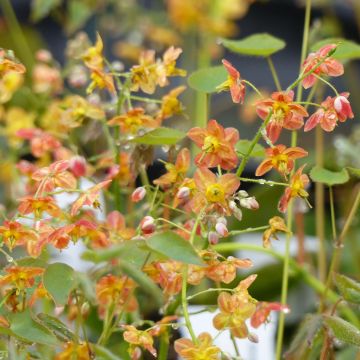

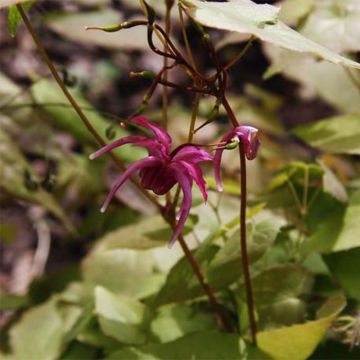

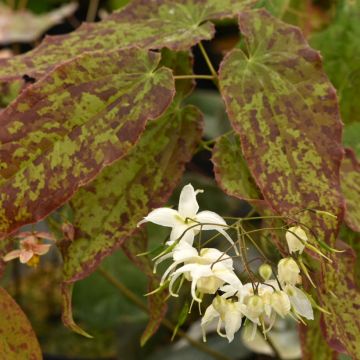

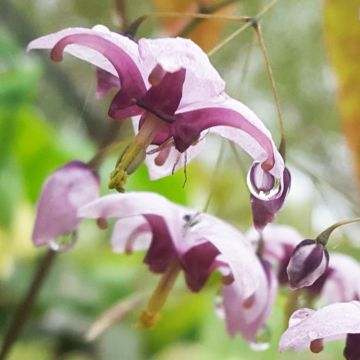
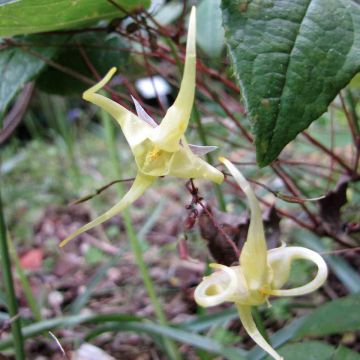

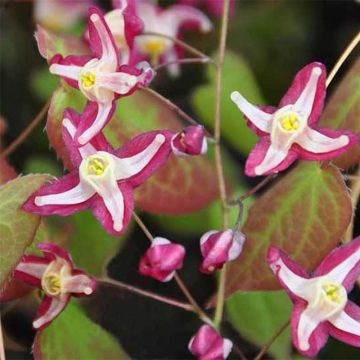
Comments